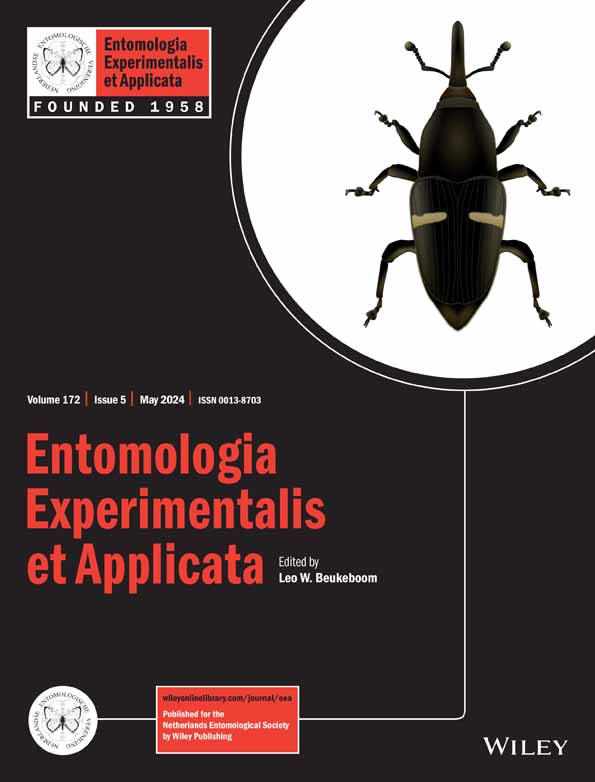Ver ítem
- xmlui.general.dspace_homeCentros e Institutos de InvestigaciónCICVyA. Centro de Investigación en Ciencias Veterinarias y AgronómicasInstituto de GenéticaArtículos científicosxmlui.ArtifactBrowser.ItemViewer.trail
- Inicio
- Centros e Institutos de Investigación
- CICVyA. Centro de Investigación en Ciencias Veterinarias y Agronómicas
- Instituto de Genética
- Artículos científicos
- Ver ítem
Direct and indirect host-related volatile compounds attract a fruit fly parasitoid, Diachasmimorpha longicaudata
Resumen
Fruit fly pests (Diptera: Tephritidae) are a serious problem for fruit production and for local and international trade. Biological control is increasingly included as a pest control tool within integrated pest management (IPM) programmes, seeking to reduce pesticides and improve fruit quality. Ceratitis capitata Wiedemann, the Mediterranean fruit fly (medfly), is probably the most damaging fruit fly pest, with a global distribution and more than 200 host
[ver mas...]
Fruit fly pests (Diptera: Tephritidae) are a serious problem for fruit production and for local and international trade. Biological control is increasingly included as a pest control tool within integrated pest management (IPM) programmes, seeking to reduce pesticides and improve fruit quality. Ceratitis capitata Wiedemann, the Mediterranean fruit fly (medfly), is probably the most damaging fruit fly pest, with a global distribution and more than 200 host species. The solitary larval endoparasitoid Diachasmimorpha longicaudata Ashmead (Hymenoptera: Braconidae) is a biocontrol agent widely used against Tephritidae fruit fly pests. Previous studies showed that female wasps locate host larvae using visual, mechanical, and chemical cues. Here, we investigated the chemical basis of female parasitoid attraction to cues that guide D. longicaudata to the host, and thus unveil volatile organic compounds that might be used in IPM programmes. Female orientation to chemical cues was tested in a Y-tube olfactometer, where attraction to C. capitata-infested oranges, oranges with residues of larval activity, oranges infected with a green mould, and overripe oranges was confirmed. Volatiles from all these types of fruit were collected and used in gas chromatography-electroantennographic detection (GC-EAD) and GC-mass spectrometry (MS) analyses. These studies allowed us to identify six candidate compounds that were present in all treated oranges but not in the control fruit (ripe and uninfested oranges): D-limonene, acetophenone, linalool, nonanal, decanal, and eugenol. Electroantennography (EAG) showed that acetophenone, nonanal, and decanal triggered dose-dependent responses, suggesting a relevant role in the process of host finding. Although responses to D-limonene, linalool, and eugenol were independent of the dose, they could be involved in host location in areas with high probability of host presence. The fact that these six compounds are shared by the four behaviourally attractive sources opens new possibilities for the development of novel tools to improve biocontrol programmes.
[Cerrar]

Autor
Devescovi, Francisco;
Fernández, Patricia;
Bachmann, Guillermo Enrique;
Nussenbaum, Ana Laura;
Segura, Diego Fernando;
Fuente
Entomologia Experimentalis et Applicata : 1–11 (First published: 06 February 2024)
Fecha
2024-02
Editorial
Wiley
ISSN
1570-7458
Documentos Relacionados
Formato
pdf
Tipo de documento
artículo
Proyectos
(ver más)
INTA/2019-PD-E4-I079-001, Genética, genómica y ecología de insectos de importancia agronómica como insumo para el desarrollo de estrategias sustentables de control plagas
Palabras Claves
Derechos de acceso
Restringido
 Excepto donde se diga explicitamente, este item se publica bajo la siguiente descripción: Creative Commons Attribution-NonCommercial-ShareAlike 2.5 Unported (CC BY-NC-SA 2.5)
Excepto donde se diga explicitamente, este item se publica bajo la siguiente descripción: Creative Commons Attribution-NonCommercial-ShareAlike 2.5 Unported (CC BY-NC-SA 2.5)


